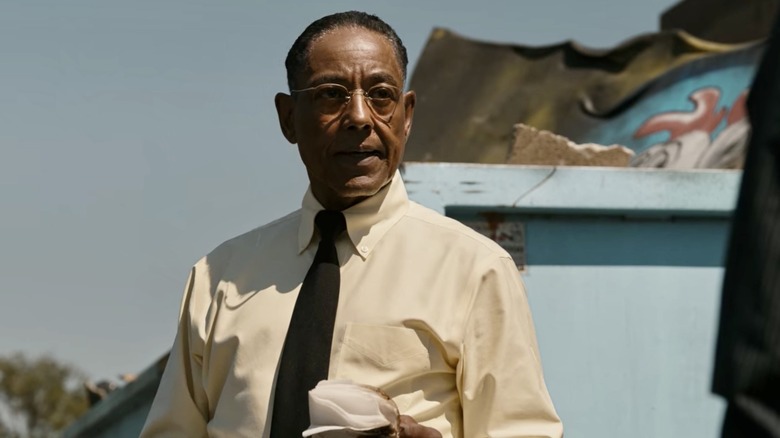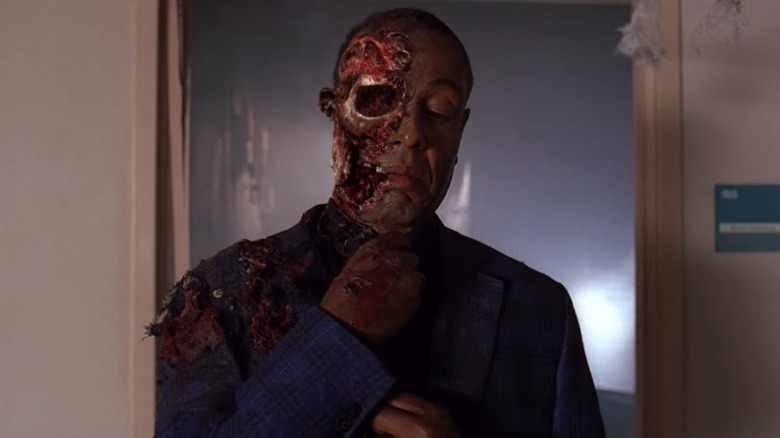Giancarlo Esposito Doesn't See The Evil In His Better Call Saul And Breaking Bad Character
Giancarlo Esposito's filmography dates back decades, and he has appeared in a number of classic films. In "Do the Right Thing," Esposito played Buggin Out, who led the attempted boycott of Sal's Famous Pizzeria for its all-white Wall of Fame. In "Malcolm X," he played one of the Nation of Islam disciples who assassinated the legendary civil rights leader. In "The Usual Suspects," he played FBI agent Jack Baer, who led the interrogation of a hospitalized burn victim to work up a police sketch of the villain Keyser Söze.
Despite being a part of famous movie moments like these, Esposito was working mostly under the radar in Hollywood until he took on the role of Gus Fring in AMC's "Breaking Bad" and "Better Call Saul." An icy drug lord who hides behind philanthropy, restaurant hospitality, and the chicken mascot of Los Pollos Hermanos, the character catapulted Esposito to a new level of visibility as an actor. It was perhaps because of his association with this role that Esposito landed other villainous parts, like his Emmy-nominated turn as Moff Gideon on "The Mandalorian."
As an actor, however, Esposito approached the part of Fring from an inherently more empathetic place than a viewer rooting against him might. You will often hear actors say they don't play their characters as villains, since everyone is the hero of their own story. Owing to this mentality, perhaps, Esposito does not see Fring as a villain in the classic sense. In an interview with Collider, he said:
"I don't know if I have any character that's classically evil. And I think that's what's changed the game for me because Gus Fring, I would immediately go to him. Because I can dive into that and I scare people in real life, but that's a part of me: When we are able to take someone in completely — give space, drop yourself down so you're listening, but seeing everything about them — it makes people uncomfortable. It truly makes them uncomfortable. Because you're not multitasking, looking at your phone or another five things, you're looking into their soul."
'No one is just evil'
If the image of Gus Fring looking into one's soul sounds scary, Giancarlo Esposito doesn't quite see it that way. He continued:
"I don't think that's a bad thing. I think it's an attentive thing. I believe that Gus was a character and is a character who really had an agenda. And his agenda wasn't necessarily evil. It was straight and to the point. So I think part of my career that's been so wonderful, and it started with really with Gus, is that no one is just evil. It's neither black nor white. It's a shade of gray. And it could be either/or, which is why I loved playing him. ... You become an amalgamation of all the good and the bad that makes you evil by the decisions you make while the camera's on."
Fring is a complex character, and his attentive nature — applied toward everything from conducting his drug business to cleaning kitchen fryers — is certainly one of his defining aspects. However, as ScreenPrism (via Laughing Squid) notes, at least part of his overall character as a ruthless meth kingpin, cloaked in fake fast-food smiles, can also be seen as a critique of capitalism and its all-consuming need for aggressive expansion and elimination of competition at the expense of public health.
"Breaking Bad" also showed how Fring was driven by a desire for revenge against Hector Salamanca (Mark Margolis) and Don Eladio (Steven Bauer) for the death of his Los Pollos Hermanos co-founder (and possible lover), Max (James Martinez). Max's death sets in motion a long-simmering revenge plan for Fring that finally culminates in his own long walk to death along with Hector (to the tune of the Apparat song "Goodbye") in a nursing home explosion in the Season 4 finale, "Face Off."
By setting Fring in opposition to these other worse villains, "Breaking Bad" arguably made the character more sympathetic, just as some viewers might have been rooting for Walter White (Bryan Cranston) as the lesser of two evils when compared to Fring. The character's final grotesque appearance in "Breaking Bad," as he adjusts his necktie with half his face blown off, serves as one last reminder of Gus Fring's dual nature.

